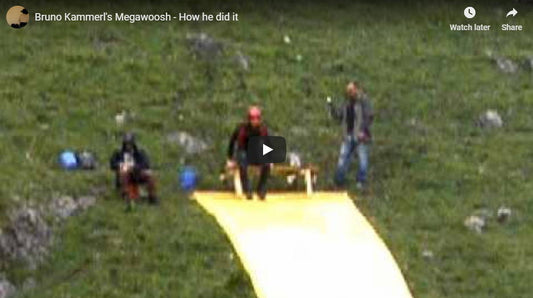Cool Videos

Sheldon Teaches Penny Physics
Awesome video for the first day of Physics! Add some humor to the classroom the first day.From The Big Bang Theory – Sheldon teaches Penny Physics, shows the importance of being a good teacher is more then knowing your Physics.
Sheldon Teaches Penny Physics
Awesome video for the first day of Physics! Add some humor to the classroom the first day.From The Big Bang Theory – Sheldon teaches Penny Physics, shows the importance of being a good teacher is more then knowing your Physics.

Vortex Rings in Nature and Your Physics Classroom!
The video illustrates Vortex Rings being formed by various sources including dolphins and volcanoes. You'll notice in the video that the Vortex Rings are quite stable until they slow down and then at some critical speed, the core enlarges very suddenly causing the vortex to breakdown. Dolphins make, watch and chase them, even using their flippers to stop them rising in what appear to be games similar to those we humans play with soap bubbles. Watch Mt. Etna emit gigantic ring-shaped clouds of steam and gas up to 200 m in diameter that can fly up to 1000 m high, lasting more than 10 minutes. Your students will realize that humans aren't the only ones who love to make and watch Vortex Rings, one of the coolest phenomena in nature! Resources: Do more with vortex rings right in your classroom, check out these great links: BBC News article: Etna hoops it up The Physics Teacher – Smoke Ring Physics vol. 49, November 2011. Acknowledgements: Thank you to Dwight "Buzz" Putnam for his assistance in writing this Cool Stuff. Buzz is a 25-year veteran physics teacher at Whitesboro High School, New York Science Teacher of the Year and host of the Regents Physics Answers television show on PBS. You can also find him refereeing high school basketball games as well as presenting at the NSTA national conferences. Products: This amazing new vortex launcher sends a strong blast of air all the way across the room! Sold out A lab full of safe, non-toxic water-based fog in 2 minutes! Sold out Makes chemical fog quick and easy. Non-flammable and non-toxic. 8 oz. spray can. Sold out
Vortex Rings in Nature and Your Physics Classroom!
The video illustrates Vortex Rings being formed by various sources including dolphins and volcanoes. You'll notice in the video that the Vortex Rings are quite stable until they slow down and then at some critical speed, the core enlarges very suddenly causing the vortex to breakdown. Dolphins make, watch and chase them, even using their flippers to stop them rising in what appear to be games similar to those we humans play with soap bubbles. Watch Mt. Etna emit gigantic ring-shaped clouds of steam and gas up to 200 m in diameter that can fly up to 1000 m high, lasting more than 10 minutes. Your students will realize that humans aren't the only ones who love to make and watch Vortex Rings, one of the coolest phenomena in nature! Resources: Do more with vortex rings right in your classroom, check out these great links: BBC News article: Etna hoops it up The Physics Teacher – Smoke Ring Physics vol. 49, November 2011. Acknowledgements: Thank you to Dwight "Buzz" Putnam for his assistance in writing this Cool Stuff. Buzz is a 25-year veteran physics teacher at Whitesboro High School, New York Science Teacher of the Year and host of the Regents Physics Answers television show on PBS. You can also find him refereeing high school basketball games as well as presenting at the NSTA national conferences. Products: This amazing new vortex launcher sends a strong blast of air all the way across the room! Sold out A lab full of safe, non-toxic water-based fog in 2 minutes! Sold out Makes chemical fog quick and easy. Non-flammable and non-toxic. 8 oz. spray can. Sold out

The Amazing Water Slide Human Projectile
The Amazing Water Slide: How it was done German engineer Bruno Kammerl, created the human projectile video clip that accumulated more than 1.4 million views worldwide. As luck would have it, I was in Europe when this hit the internet and other news media, and thought this was another "CoolStuff" opportunity. Those that are internet savvy can tell you, that this clip sparked science discussions all over the world. Was it real or was it fake? That was the question that brought science educators once again to the fore front. This video was a carefully crafted viral ad for Microsoft's Office Project 2007 in Germany. Kammerl had come up with a special type of neoprene material called "Softslide" and he described it as "almost frictionless" on his website. He then came upon a sponsor who financially helped him achieve his goal of the longest and most exciting waterslide in the world. The creation and testing of this slide in the German Alps lead to the production of the video. Of course it's all fake; the result of careful editing and creative video production. From Janko Roettgers Blog 8-11-2009: Kammerl's web site was registered in May by an employee of the German subsidiary of marketing giant MRM Worldwide. Chatter about this connection popped up online only a few days after the waterslide video started to become popular, and MRM Worldwide quickly decided to lift the curtain. Microsoft's logo was added to Kammerl's Megawoosh.com web site late last week, and MRM Germany CEO Alexander Ewig finally fessed up to his company's involvement in a press release emailed to us today, saying: "We developed Megaswoosh as a viral campaign for Microsoft Germany." "This revelation was supposed to come a little later," I was told by Maik Koenigs, whose Hamburg-based viral marketing agency Elbkind was hired by MRM to seed the video onto more than 60 sites. However, bloggers were too quick to make the connection, so there had to be a change of plans. "Viral communication is a dynamic process," he explained, adding that the outcome was still beyond everyone's expectations. The campaign was just meant to be for a German audience, but has gotten Twitter, blog and mainstream media responses from all over the world. So how was the video really done? As some bloggers guessed, it's a case of creative compositing, meaning that the clip we get to see is based on multiple elements that were combined together to create a final video. A stuntman slides down the slide, secured by a rope. Then there's a body flying through the air, which is animated. And finally, the big splash. "He actually jumped from a wooden ramp into the pool," explained Koenigs. Of course, you don't get to see any of this in the final clip, thanks to careful editing that makes it look like a single take. Here's a short, unedited clip that shows how the stuntman filling in for Kammerl is sliding down part of the slide for a first segment of the final video: So yes, it was fake. As is so much of the world students are exposed to these days. However, they are entertaining, fun and sometimes baffling. But what a great opportunity for discussion. When something like this comes along, questions, theories and hypothesis's begin to flow. Engage, Explain and Expand…
The Amazing Water Slide Human Projectile
The Amazing Water Slide: How it was done German engineer Bruno Kammerl, created the human projectile video clip that accumulated more than 1.4 million views worldwide. As luck would have it, I was in Europe when this hit the internet and other news media, and thought this was another "CoolStuff" opportunity. Those that are internet savvy can tell you, that this clip sparked science discussions all over the world. Was it real or was it fake? That was the question that brought science educators once again to the fore front. This video was a carefully crafted viral ad for Microsoft's Office Project 2007 in Germany. Kammerl had come up with a special type of neoprene material called "Softslide" and he described it as "almost frictionless" on his website. He then came upon a sponsor who financially helped him achieve his goal of the longest and most exciting waterslide in the world. The creation and testing of this slide in the German Alps lead to the production of the video. Of course it's all fake; the result of careful editing and creative video production. From Janko Roettgers Blog 8-11-2009: Kammerl's web site was registered in May by an employee of the German subsidiary of marketing giant MRM Worldwide. Chatter about this connection popped up online only a few days after the waterslide video started to become popular, and MRM Worldwide quickly decided to lift the curtain. Microsoft's logo was added to Kammerl's Megawoosh.com web site late last week, and MRM Germany CEO Alexander Ewig finally fessed up to his company's involvement in a press release emailed to us today, saying: "We developed Megaswoosh as a viral campaign for Microsoft Germany." "This revelation was supposed to come a little later," I was told by Maik Koenigs, whose Hamburg-based viral marketing agency Elbkind was hired by MRM to seed the video onto more than 60 sites. However, bloggers were too quick to make the connection, so there had to be a change of plans. "Viral communication is a dynamic process," he explained, adding that the outcome was still beyond everyone's expectations. The campaign was just meant to be for a German audience, but has gotten Twitter, blog and mainstream media responses from all over the world. So how was the video really done? As some bloggers guessed, it's a case of creative compositing, meaning that the clip we get to see is based on multiple elements that were combined together to create a final video. A stuntman slides down the slide, secured by a rope. Then there's a body flying through the air, which is animated. And finally, the big splash. "He actually jumped from a wooden ramp into the pool," explained Koenigs. Of course, you don't get to see any of this in the final clip, thanks to careful editing that makes it look like a single take. Here's a short, unedited clip that shows how the stuntman filling in for Kammerl is sliding down part of the slide for a first segment of the final video: So yes, it was fake. As is so much of the world students are exposed to these days. However, they are entertaining, fun and sometimes baffling. But what a great opportunity for discussion. When something like this comes along, questions, theories and hypothesis's begin to flow. Engage, Explain and Expand…

Vector Addition Demo
A truck is traveling 60mph (Constant Velocity), a baseball shoots out of the back at 60mph. Do you really expect the ball to drop straight down? The following video from a Japanese TV show should be a good laugh for anyone teaching science, regardless of what area you focus on. This video uses a vehicle traveling at high speeds, combined with a radar gun and a mounted baseball pitching machine. Using creativity and access to a driving test track, they drive the vehicle 100km/Hr in one direction while hurling a baseball 100km/Hr in the opposite direction. From the frame of reference (the earth), the two velocity's vectors are represented with opposite numerical signs, one being positive and the other negative. The net result when adding these vectors is zero velocity relative to the earth and the ball drops straight down. When the slow motion video is shown, it provides a stunning example of net velocity and vector addition and can lead to a discussion of Galilean relativity. Please Note: forward past the first 26 seconds, since it is an introduction to the show in Japanese. Thank you to Buzz Putnam of Whitesboro High School for sharing this video! We certainly don't recommend trying this one at home, or at school, but you can show them this video, and with the mute setting and your commentary, this could be a fun way to introduce this concept to your students in an engaging and educational way. This just in: In response to the Coolstuff newsletter email, Stanley Micklavzina of the University of Oregon shares this vector addition related video from the popular Mythbusters television series. Velocity and vectors are often among the first topics covered in the Physics classroom and a key concept to grasp early on for most other science disciplines. It is also one of the more difficult subjects for a student to understand. The good news is that it can be a fun subject to demonstrate. Active demonstrations can help lead your students to a much deeper understanding of the concepts they need to grasp for whatever subject you teach. Of course, an even better way to introduce students to this concept is to show them in person.
Vector Addition Demo
A truck is traveling 60mph (Constant Velocity), a baseball shoots out of the back at 60mph. Do you really expect the ball to drop straight down? The following video from a Japanese TV show should be a good laugh for anyone teaching science, regardless of what area you focus on. This video uses a vehicle traveling at high speeds, combined with a radar gun and a mounted baseball pitching machine. Using creativity and access to a driving test track, they drive the vehicle 100km/Hr in one direction while hurling a baseball 100km/Hr in the opposite direction. From the frame of reference (the earth), the two velocity's vectors are represented with opposite numerical signs, one being positive and the other negative. The net result when adding these vectors is zero velocity relative to the earth and the ball drops straight down. When the slow motion video is shown, it provides a stunning example of net velocity and vector addition and can lead to a discussion of Galilean relativity. Please Note: forward past the first 26 seconds, since it is an introduction to the show in Japanese. Thank you to Buzz Putnam of Whitesboro High School for sharing this video! We certainly don't recommend trying this one at home, or at school, but you can show them this video, and with the mute setting and your commentary, this could be a fun way to introduce this concept to your students in an engaging and educational way. This just in: In response to the Coolstuff newsletter email, Stanley Micklavzina of the University of Oregon shares this vector addition related video from the popular Mythbusters television series. Velocity and vectors are often among the first topics covered in the Physics classroom and a key concept to grasp early on for most other science disciplines. It is also one of the more difficult subjects for a student to understand. The good news is that it can be a fun subject to demonstrate. Active demonstrations can help lead your students to a much deeper understanding of the concepts they need to grasp for whatever subject you teach. Of course, an even better way to introduce students to this concept is to show them in person.

Newton’s First Law: Supersized!
Galileo theorized that in the absence of any other force, a moving object will continue to move. He called this resistance to changes in motion, inertia. Sir Isaac Newton later polished this concept – turning it into his first law, the Law of Inertia. From his Principia: Every object continues in a state of rest or of uniform speed in a straight line unless acted on by a nonzero net force. In other words, if an object is moving in a direction, it will continue to move in that direction unless another force is exerted upon it. Likewise, if an object is in a state of rest, the law of inertia requires the object to stay in that state unless another force is exerted upon it. In the following dramatization, your students will see an extreme example of Newton's First Law in action! We aren't sure if this REALLY occurred without some help from Hollywood, but it certainly gets the point across. NOTE: This movie was proven "fake" on Mythbusters, but it's still a fun way to demonstrate Newton's law of inertia. Check out the products from Arbor Scientific below for the Inertia Apparatus – a great way to demonstrate Newton's First Law – and other items that illustrate other Newtonian Laws! Explorations: Newton's Third Law: The rotors push air downward, and the air exerts an upward force on the rotors. Rotational Motion: Counter-rotation of parts shows conservation of angular momentum and provides vertical stability. Light and Waves: Infrared controller communicates commands. See the IR signals with a digital camera! To operate, plug the flyer into the charging base. (8 AA batteries not included. We recommend using rechargeable batteries.) A 20-30 minute charge lets you fly for about 8 minutes. Maximum height of over 20 feet.
Newton’s First Law: Supersized!
Galileo theorized that in the absence of any other force, a moving object will continue to move. He called this resistance to changes in motion, inertia. Sir Isaac Newton later polished this concept – turning it into his first law, the Law of Inertia. From his Principia: Every object continues in a state of rest or of uniform speed in a straight line unless acted on by a nonzero net force. In other words, if an object is moving in a direction, it will continue to move in that direction unless another force is exerted upon it. Likewise, if an object is in a state of rest, the law of inertia requires the object to stay in that state unless another force is exerted upon it. In the following dramatization, your students will see an extreme example of Newton's First Law in action! We aren't sure if this REALLY occurred without some help from Hollywood, but it certainly gets the point across. NOTE: This movie was proven "fake" on Mythbusters, but it's still a fun way to demonstrate Newton's law of inertia. Check out the products from Arbor Scientific below for the Inertia Apparatus – a great way to demonstrate Newton's First Law – and other items that illustrate other Newtonian Laws! Explorations: Newton's Third Law: The rotors push air downward, and the air exerts an upward force on the rotors. Rotational Motion: Counter-rotation of parts shows conservation of angular momentum and provides vertical stability. Light and Waves: Infrared controller communicates commands. See the IR signals with a digital camera! To operate, plug the flyer into the charging base. (8 AA batteries not included. We recommend using rechargeable batteries.) A 20-30 minute charge lets you fly for about 8 minutes. Maximum height of over 20 feet.


